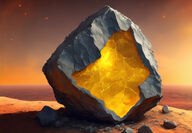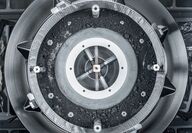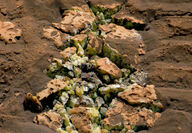Sorted by date Results 1 - 20 of 20

Study suggests Martian rocks may be saturated with fuel-building ingredients. Onsite production of materials such as fuel and construction resources have been under study to extend the distances and livability of space exploration. Rockets that can make or collect fuel can go farther, and astronauts that don't need to bring their own tools and building materials can stay in space longer. This use of the surrounding environment to produce new materials has its own discipline...

Built and deployed in space, new plasma rockets that burn metals could power long-range spacecraft. The Super Magdrive – a seminal technology and namesake of its British-based space tech startup, Magdrive, can use any metal, including iron, as a fuel source to power long-range spacecraft farther for longer. These new bullet-shaped thrusters can technically be infinitely refueled on the go by the metals from mining asteroids, comets, and other space resources. The new t...

Space mining could provide rare earths, iron, hydrogen, and other in-situ resources for lunar and Martian outposts. The most expensive aspect of space exploration comes in the form of moving payloads. Every ounce on a rocket requires a fuel increase, resupply missions are expensive, and as astronaut crews – human or robotic – become more independent of Earth, long-term missions become increasingly feasible. Future astronauts will need to collect and process ext...

Based on new simulations, a team of geoscientists suspects Mercury may have a 10-mile-thick layer of diamonds buried beneath its graphite grey surface. While we can't yet go digging to prove it, a new study reveals the likely presence of a layer of diamond nearly ten miles thick at the boundary between Mercury's core and mantle. When viewed by spacecraft from 2011 to 2015, Mercury appeared exceptionally grey due to the high concentrations of graphite, which is pure carbon, on...

NASA rovers looking for evidence of life make surprising revelations for the future of space mining as well. In the last two months of an ongoing search for signs of ancient life on Mars, NASA's Perseverance and Curiosity have been wheeling around the red planet looking for rocks that may have been created or modified long ago by the presence of water and microbial life. Meanwhile, a rich volcanic history may produce other treasures as well. A vein of spotted rocks nicknamed...

Scientists have already found several revelations studying material from the asteroid sample brought back to Earth by the OSIRIS-REx mission. Launched back in 2016, a spacecraft traveled to near-Earth asteroid Bennu and collected a large sample of rocks and dust from the surface. This first U.S. mission to collect a sample directly from an asteroid delivered its payload back to Earth on Sept. 24, 2023. At last, early analysis of the sample of asteroid Bennu returned by NASA's...

Curiosity rover cracks open a rock with yellow sulfur crystals, an unexpected find that poses new questions for earthbound scientists. While exploring a region of the Martian landscape that has all the telltale signs of ancient floods and landslides that occurred when Mars' climate was much more like Earth than the frozen desert it is today, NASA's Curiosity made a surprising discovery – the first ever pure sulfur ever discovered on the Red Planet. This Martian minerals d...

Carbon nanomaterial identified in lunar soil samples brought back by China's Chang'e-5 mission could shape future and rewrite history. Graphene is a 2D carbon material that is 200 times stronger than steel, lighter than paper, and boasts extraordinary mechanical and electrical properties. So, having this phenomenal nanomaterial naturally occurring on the Moon's surface could be an extremely valuable resource for future lunar bases that serve as a launching point for...

The 24th sample taken by the six-wheeled scientist offers new clues about Jezero Crater and the lake it may have once held. As of April 4, Perseverance has been active on Mars for 1,110 sols or three years, one month, and 17 days in Earth time since its landing. In that time, the lonely rover collected 24 samples, but the latest embodies exactly why NASA sent the six-wheeled scientist to the Red Planet. The mission of the Mars 2020 Perseverance rover is to focus on...

In lieu of aliens or secret government bases, there is a very real and persistent threat on the Moon to future astronauts on NASA's Artemis mission – dust. This powdery substance is far from the commonplace kind we're used to earthside. Lunar dust is the finest fraction of crushed regolith easily disturbed and distributed throughout the low-gravity atmosphere of the Moon. It differs significantly in its origin and properties from terrestrial soil. On Earth, particles are w...

After seven years and nearly 4 billion miles, mission returns with sample of asteroid that may offer secrets of the universe. After seven years hurtling through the solar system, NASA's OSIRIS-REx space mission ended in a resounding success as its precious cargo tore through Earth's atmosphere to touch down in the Utah desert. Launched on Sept. 8, 2016, the initially $800 million Origins, Spectral Interpretation, Resource Identification, and Security-Regolith Explorer, or OSIR...

Gemstones could offer evidence of past life and be a water source for future Martians. Martian opals discovered in a lakebed traversed by NASA's Mars Curiosity rover may be much more precious than their counterparts found on Earth. This is not due to the opals found on the Red Planet being more opalescent, dazzling, or exotic – though a pendant adorned with Martian opals would truly be out of this world – but because they may be a key to understanding past life and ena...

Perseverance is dropping off a batch of samples for Mars Sample Return robotic team to retrieve. While the impressive toolkit aboard the Perseverance rover provides earthbound scientists with a trove of data on the geological and biological history of Mars, the ultimate goal is to get rock and dirt samples collected by the robotic geologist back to Earth for closer examination. Toward this objective, Perseverance is wrapping up its prime mission by creating a depot of samples...

With 2022 coming to a close, NASA has announced the 15 teams moving forward to the semi-finals in the $3.5 million Break the Ice Lunar Challenge, an ongoing competition that puts research groups, robotics teams, and private companies in head-to-head trials to design future-tech rovers to harvest the most valuable commodity of all in outer space, water. "We're putting humanity back on the Moon with the Artemis missions, and this is a team effort on a global scale," said Amy...

Food, water, breathable air, shelter, and clothing – these fundamental elements of human survival here on Earth will be even more critical for early Mars colonists. With delivery fees measured in millions of dollars and wait times for rush orders being at least six months, Red Planet pioneers are going to need to be able to produce their own survival goods. Researchers at the Swinburne University of Technology in Australia are developing a process that co-produces two of t...

NASA's eighth annual Breakthrough, Innovative and Game-Changing (BIG) Idea Challenge invites university students to design a metal production pipeline – from extracting metal from minerals to creating structures and tools – for the Moon. "Here at home, forging metal has long been a key part of building our homes and infrastructure, and the same holds true as we work towards a sustained presence on the Moon," said Niki Werkheiser, director of technology maturation within NAS...

Aiming to kick off the Artemis era later this year, NASA is preparing for the first launch of its Space Launch System (SLS) mega-rocket carrying the Orion spacecraft, which will fly without any crew around the Moon and back on a trip lasting between 26 and 42 days. NASA hopes this Artemis 1 mission will be a steppingstone to its next giant goal, landing astronauts at the lunar south pole by the end of 2025. On the morning of March 17, the world's largest set of doors rolled...

The University of Adelaide has launched Exterres Laboratory, the first of its kind in Australia for an off-Earth surface testing environment for space technology such as rovers – which are destined for the furthest reaches of the universe. The Extraterrestrial Environmental Simulation (Exterres) Laboratory, located on North Terrace campus, will provide a crucial stepping-stone in developing the technology required to accompany humankind back into deep space. With it, researche...

The National Aeronautics and Space Administration March 7 reported the nearing launch of its 11-year Psyche project, with the assemblage of its massive solar panels that will power the spacecraft through its nearly four-year journey. Scheduled to launch on Aug. 1, the Psyche spacecraft will travel 1.5 billion miles to a mysterious, metal-rich asteroid of the same name. "Seeing the spacecraft fully assembled for the first time is a huge accomplishment; there's a lot of pride,"...

Are we there yet? With only about 1.4 million miles to go, the Hayabusa 2 spacecraft is about to finish its primary mission that has carried it over 3.25 billion miles so far! Even though it reached the near-earth asteroid Ryugu, a mere 7.5 million miles away as the space crow flies, and retrieved samples to return, the overall success of the mission depends on whether it can safely return those samples to Earth. Unlike its predecessor, Hayabusa 1, which burned up on reentry,...